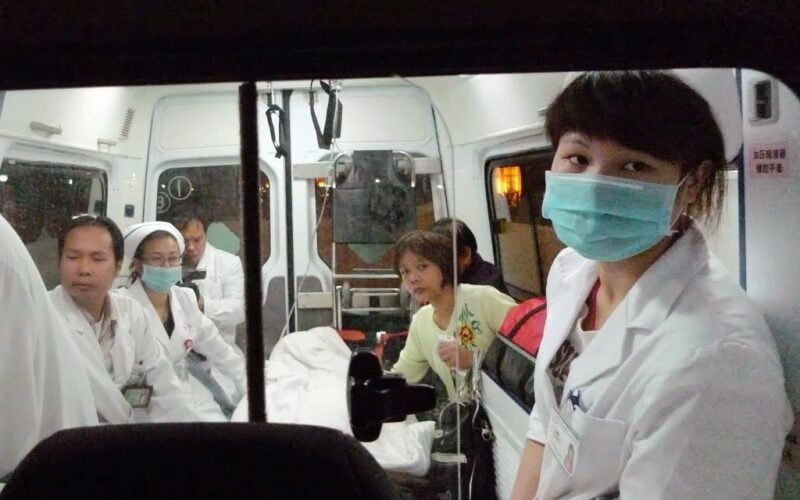Three reasons why you shouldn’t have a heart attack in China

by Michael Woodhead
This week’s major new research findings on heart attack in China have been reported as showing a four-old increase – as if China is simply catching up with the west in terms of heart disease. The media reports missed the more important message from this study, which is that treatment of heart attack in China still has a long way to go.
To understand the findings of the Chinese research you need to know a bit of context. In western countries such as the UK and the US there has been a real revolution in the way that heart attacks are treated – and some very real progress in surviving a heart attack. Just a few decades ago, a heart attack was a death sentence – few people survived them, and those who did often were crippled by the ongoing coronary disease or killed off by recurrent attacks.
Transportation to a hospital
These days, all that has changed because coronary arteries can be unblocked. With early recognition of the signs, and swift transport to hospital (with early rescue treatment started in a cardiac-equipped ambulance), a heart attack can be a survivable event with a reasonably good prognosis for the person who has their blocked coronary arteries cleared and kept open with a stent and or a ‘clotbuster’ (thrombolytic).
Long term prospects are also improved for those who take the right medical therapies such as anti-platelet drugs, beta-blockers and statins – and of course for those who make the necessary lifestyle changes of stopping smoking, doing more activity and eating healthily. What the report in the Lancet shows is that China is still decades behind the west when it comes to these basic steps – and the survival rates for heart attacks reflect this.
The report from the so-called ‘China PEACE—Retrospective Acute Myocardial Infarction Study’ is one of the first national snapshots of heart attack treatment to come out of China. It sampled about 4% of all coronary treatment units, and found that – as reported, rates of ST-segment Elevation Myocardial Infarction (STEMI) heart attack rose about four-fold (from 4 per 100 000 in 2001 to 16 in 2011). It also showed that in many aspects there had been little progress in treatment of heart attack over the last decade.
Firstly, most people who have a heart attack in China take far too long to get to hospital – averaging about 12 hours. Compare that to western countries, where the average time from the onset of coronary symptoms to actually going under the knife is now as little as three to four hours (remember there can be delays of hours between being admitted to hospital and getting into the catheter lab, the so-called ‘door to balloon time’).
Delays getting to a hospital
These long delays in getting to hospital mean that Chinese people with heart attacks are missing out on the ‘treatment window’ for re-opening those blocked coronary arteries – this is best done within the first few hours of a heart attack before cardiac tissue starved of oxygen dies. The study results showed that less than half of Chinese patients qualified for treatment, and only about a quarter got reperfusion procedures, whereas in western countries about 80% of heart attack patients have treatment such as angioplasty and stenting to re-open occluded coronary vessels.
And in terms of additional medical treatments, Chinese patients also miss out. While most now are prescribed blood-thinning aspirin and a statin (lipid lowering) drug, only about 60% get the recommended cardiovascular drug treatments such as beta-blockers and ACE inhibitors. With these continuing ‘treatment deficits’ it’s not surprising that survival rates for heart attack have improved little in China over the last decade.
Lancet commentary
The Lancet commentary thus concludes by saying:
“Major emphasis must be placed on early patient presentation (requiring public education of acute myocardial infarction symptoms and prompt response), followed by rapid diagnosis and reperfusion therapy in all appropriate patients (ultimately with primary percutaneous coronary intervention or a pharmacoinvasive strategy). Equally important is establishment of high-quality continuity of care and efforts at secondary prevention after hospital discharge.”
Chinese patients need three things:
- To recognise signs of a heart attack and get to a hospital immediately.
- To get early coronary reperfusion treatment from a cardiac unit.
- To be prescribed the basic drugs to preserve and maintain coronary function.
(I haven’t even touched on things like the lack of cardiac rehab and the sky-high smoking rates in China).
The question is: does China have the paramedics, cardiologists and hospital facilities to achieve a Great Leap Forward in coronary care?








